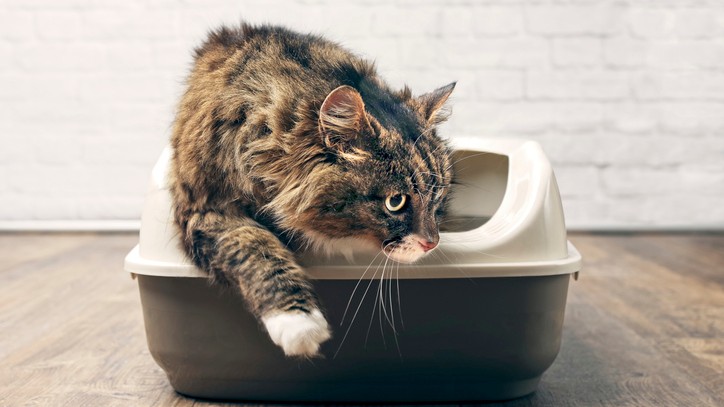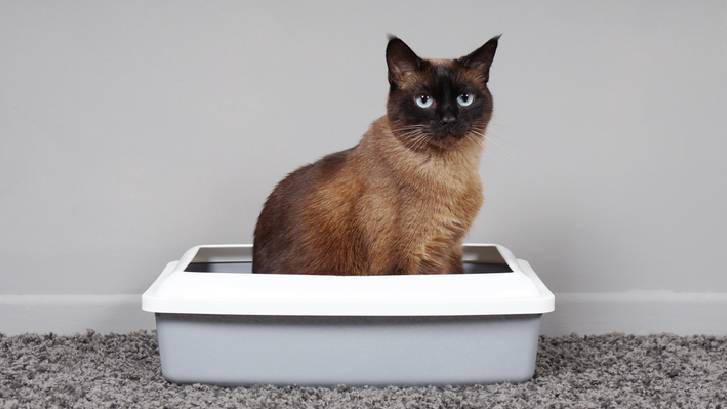How to keep cat litter off the floor
Fed up with cat litter tracking? Learn how to keep cat litter off the floor and in the litter box where it belongs with our top tips and recommendations

If you’re at your wit’s end trying to figure out how to keep cat litter off the floor and stop your kitty from tracking it everywhere, you’ve come to the right place!
There are many benefits to cat ownership, and it’s likely that you love your feline friend a great deal. But there are some drawbacks that are less than desirable, and finding annoying bits of cat litter throughout your house is just one of those.
Even if you’ve purchased the best cat litter that money can buy, there’s still a chance that some of it will end up on your floor, especially if you have a kitty that loves to play about in it and dig up a storm, which some of them do.
In this piece we’ll be looking at some tips for dealing with the problem of litter tracking, giving you pointers to stop it altogether and have a happier (and litter-free) home for you and your kitty.
What causes cat litter tracking?
On the whole, cats are pretty clean creatures, and it’s great that they tend to keep their business to one location in your house – try training a dog to use what is effectively a toilet, that’s definitely not going to happen, so there’s a lot to be thankful for when it comes to cat ownership.
However, cat litter tracking, when your feline friend drags small bits of litter materials around your house, is not exactly pleasant, and can even be uncomfortable when you tread on it or if it ends up in your shoes.
It’s usually caused by pieces of litter getting stuck to your cat’s paws or fur after they’ve used the litter tray. You may also have a cat that likes to dig or scratch in the litter box to cover up their business – flicking bits of litter over the side of the box that gets easily walked around the house.
Litter tracking can be more common with some litters than others and it can also be more of an issue if the litter box is placed somewhere more prone to being a “high-traffic” area, or the type of surface you place your litter box on. Luckily there’s plenty of things you can do to alleviate the problem.
How to stop cat litter tracking
There are a few basic things you can try in order to help stop or significantly reduce cat litter tracking.
It might also help to try a number of these in combination depending on how severe the problem is, or if you’re finding that one on its own doesn’t quite work as well as you might want it to.
We’ll expand more on this list in the next section but consider the following tips to stop cat litter tracking:
- Think about the type of litter you use
- Tidy in and around the litter box more often
- Keep the litter tray confined and away from high-traffic areas
- Invest in a high-sided or covered litter box
- Use special litter mats to catch the litter from your cat’s paws
How to keep cat litter off the floor

If you want to keep your cat’s litter in the place it’s supposed to be - aka the litter box, then here’s some more information about the above tips.
1. Type of litter
Many cats have a particular penchant for certain types of cat litter, and they simply won’t go if you don’t have the right type.
If you’ve had your cat for a while, then chances are you’ll have already figured out what they like. However, if litter tracking is becoming a problem for you - you might want to consider switching (carefully and slowly) to a brand that is specifically designed to reduce tracking.
Have a look at our guide to the best cat litters, as several of our recommendations are “low tracking” or are more likely to prevent it from happening than others. You might also want to consider these cat litter alternatives, too, some of which may be considerably less likely to track around the house.
2. Frequent cleaning
This is a bit of an obvious suggestion, but sometimes the simplest solutions need repeating.
Try to make sure that the area around the cat’s litter tray is as clear as possible, paying a visit a couple of times a day to remove any debris that might have made its way onto the floor.
It can be handy to keep a dustpan and brush near to the tray ready for a quick clean-up, or you might want to use a small handheld vacuum cleaner if you prefer.
Every week or so, sweep underneath the litter box to remove any pieces that have got trapped under there, too. When you completely change the litter, try placing the whole tray into a trash bag to dispose of the contents, then you’ll avoid stray drop-offs.
Here’s some more info about how to clean a cat litter box.
3. Confine the tray
Another way to prevent pieces of litter from escaping is to confine the litter tray in some way. That could be by placing it in another larger tray or box so that hopefully most of the litter debris will land in the larger tray and not end up on the floor.
You should also aim to place the litter tray away from so-called high-traffic areas in your house so that the litter isn’t spread by it being picked up on your or your family’s feet.
If you have somewhere such as a downstairs bathroom or even a basement that you can keep the litter tray, then those are ideal places for the litter tray to live - your cat will probably prefer the privacy too. If you have a shower cubicle downstairs, that can also be a handy place to keep it if you don’t use it all that frequently.
4. High-sided and self-cleaning litter boxes
High-sided litter boxes help to prevent tracking by forcing your cat to jump out of the litter box, not dragging the litter with her on her paws. Most high-sided litter boxes have a front entrance that the cat can’t get back out of, instead having a hole at the top that they can jump out from when they have done their business.
You could also consider the best automatic cat litter boxes, which tend to be more expensive than regular litter trays, but can save you a lot of hassle and time, and therefore can be a worthy investment.
5. Special litter mats
Another simple and easy way to prevent litter tracking is by using litter tray mats. These work by dislodging litter from your cat’s paws before they’ve had a chance to spread it around the house. The key here is to make sure the mat is large enough that the cat doesn’t jump straight over it, while it also needs to be rough enough to snag that litter away from the paw.
You can use standard rugs and mats, but mats designed specifically for this purpose tend to do a better job. You can even get mats that are double layered in order to catch the litter underneath for easy disposal.
Read next: How to get a cat to use a litter box and how to reduce cat litter smells. Or, learn how self-cleaning litter boxes work.
PetsRadar Newsletter
Get the best advice, tips and top tech for your beloved Pets
Amy Davies is a freelance writer and photographer with over 15 years experience. She has a degree in journalism from Cardiff University and has written about a huge variety of topics over the years. These days she mostly specialises in technology and pets, writing across a number of different titles including TechRadar, Stuff, Expert Reviews, T3, Digital Camera World, and of course PetsRadar. She lives in Cardiff with her dog, Lola, a rescue miniature dachshund.

